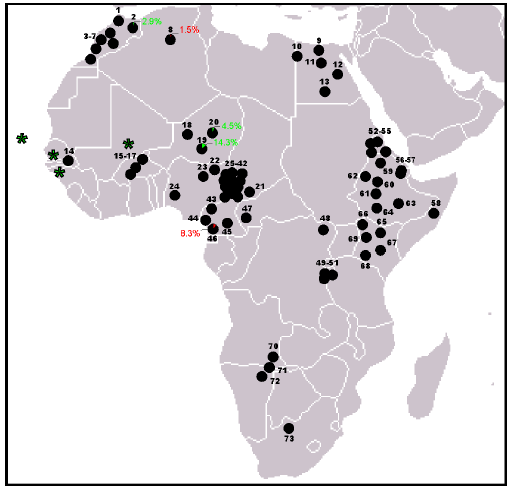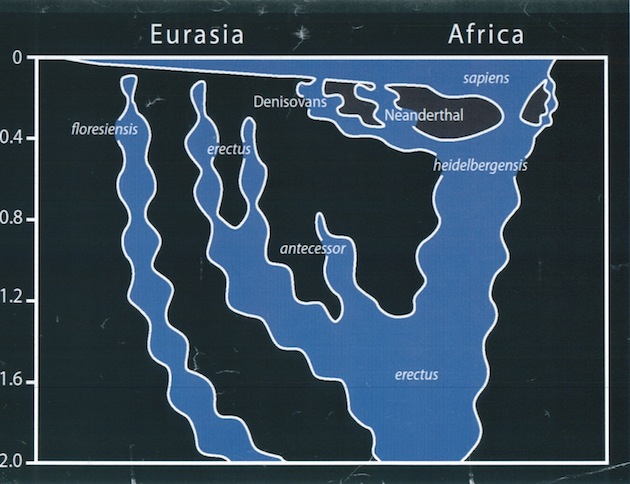The out of Africa replacement theory is outdated. Gene flow came out of Africa at one point , but it wasn't some small band of explorers that replaced all other types of humans, which was the official story.
Show me WHERE the OOA is dated. It seems you're blowing a bunch of nonsense out of nowhere. And who the heck was even talking a replacement theory????
Is Chris stringer some fringe scientist?
Watch the video again because nowhere is he saying the stuff you are saying. What he is really saying is that Archair humans like Neanderthals were STILL around during the OOA and that there was still interbreeding and the Archair human DNA did not vanish. I'm actually well versed on Chris Stringers work and here's a link on his "
Rethinking Out of Africa".
The Homo Sapien group that moved out of Africa interbred with the Neanderthals, and later on with Denisovans. Meaning Denisovans were still around during the OOA.
Or its due to the multiple Homo Sapien OOA streams later mixing Denisovans admixture with Neanderthals Homo Sapien. Since the Neanderthals not Denisovans distribution hasn't been spread equally (Europe-Asia).
(1-4%) contribution to the gene pools
I interpret this as multiple intrusions/ OOA of Homo Sapiens coming into Asia and Europe, bringing in a variety of this gene distribution (in later arrivals).
Chris states:
We don't know the circumstances of the interbreeding—we don't know if these were groups that came together peacefully, or maybe some modern humans were lacking mates and decided to capture some from a neighboring group. It can't have been that common a behavior, or there would be a lot more DNA from these archaic people.
To me this means Homo Sapiens were evolving faster than other
"species", And this is perhaps also in the ancestral loop. Where we split off from the Neanderthals, Denisovans and other "species".
Chris states:
We can see the focus, the center of evolution, for modern humans in Africa apparently moving around from one place to another, driven by climate changes. 110,000 years ago the Sahara was not desert, it was well-watered, with extensive lakes and rivers.
Again does not agree with what you were saying. But more importantly tells us my fossils in this part of the world is lacking until recent times...
Chris states"
And we see evidence of human occupation in the form of stone tools right across the region. At other times those populations completely vanished, and we pick up the evidence of evolving modern humans in East Africa, or down in the south instead. And we have to remember that there are large parts of Africa where we have stone tools, but no fossil record to show us who was making those tools.
We've got no ancient human fossils from central Africa or West Africa, none at all. So we have to bear in mind that our picture is still limited in terms of the sites that have been excavated and the information we've got from them.
Shows why very early Homo Sapien distribution is found in East and South Africa.
They haven't found any remains in Central and West Africa as of yet, due to the large field coverage. So this picture is not clear.
Chris also states:
So for me, the exact processes involved in our African origin are still unclear. We don't know exactly when it happened, we don't know exactly where it happened. We have modern human fossils from Ethiopia at 160,000 years at Herto and 195,000 years from Omo Kibish. These do look physically like a more robust version of people today, but I think we're also learning that alongside those modern-looking people were surviving forms of more archaic humans, at sites like Omo Kibish, Ngaloba, Singa and Eyasi.
Maybe any of these are ancestral to Homo Sapiens? Who died out earlier, just like the Neanderthals and Denisovans died out. But leaving a large genetic stem on Modern Humans, or were perhaps the proto-Homo Sapiens????
Chris states:
To test the robustness of the backbone and the root of current Y chromosome phylogeny, we searched for SNPs that might be informative in this respect. To this aim, a resequencing analysis of a 205.9 kb MSY portion (183.5 kb in the X-degenerate and 22.4 kb in the X-transposed region) was performed for each of seven chromosomes that are representative of clade A (four chromosomes belonging to haplogroups A1a, A1b, A2, and A3), clade B, and clade CT (two chromosomes belonging to haplogroups C and R) (Table S1 available online).
--Fulvio Cruciani,
A Revised Root for the Human Y Chromosomal Phylogenetic Tree: The Origin of Patrilineal Diversity in Africa
http://www.ncbi.nlm.nih.gov/pmc/articles/PMC3113241/
Chris even states:
Some of the most fascinating ongoing research topics in the next year or two will be homing in on the DNA that some of us have acquired from Neanderthals, that some people have acquired from the Denisovans, and that some African people have acquired, perhaps even from Homo heidelbergensis.
Homo Heidelbergensis. which is the oldest of the bunch. The one that originated in Africa.
 http://humanorigins.si.edu/evidence/human-fossils/species/homo-heidelbergensis
http://humanorigins.si.edu/evidence/human-fossils/species/homo-heidelbergensis
Chris also states:
For example there is evidence both from fossils and recent DNA that even Africa had an overlap of modern and archaic humans, with the possibility in a continent so large that there were other descendants of heidelbergensis living there alongside Homo sapiens.
We knew heidelbergensis had gone two ways, to modern humans and the Neanderthals.
All in all Chris Stringer does not agree with your claims that the Out of Africa is dated and should be replaced with the multiregional theory.

The multiregional theory is hardly taken serious in academia. Multi-Regional theory that modern man evolved in different Regions of the world is not supported by genetics or even microbiology.Out Of Africa is supported by genetics and microbiology.I read that a bacteria called "Heliocobacter Pylori" which is part of our stomach flora has
been traced BACK TO AFRICA based on it's own phylogeny.

OOA dated? Dated my ass.













 now adress my theory how does a full a African have such weak genes if there not mixed?
now adress my theory how does a full a African have such weak genes if there not mixed?
